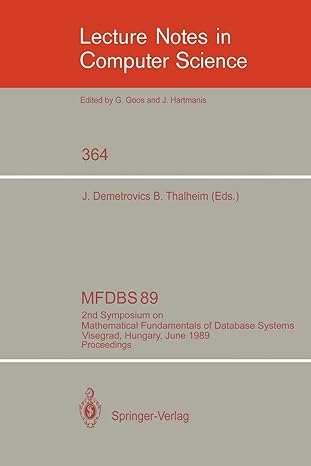Answered step by step
Verified Expert Solution
Question
1 Approved Answer
it is just disjoint set structure and algorithms Q3 (15 points) This question is related to disjoint set operations. Assume that we are using union







it is just disjoint set structure and algorithms
Q3 (15 points) This question is related to disjoint set operations. Assume that we are using union by rank and find with path compression. Suppose that you are given a disjoint set structure described by the following array. The following three sub-questions all refer to this disjoint set (not the disjoint set you obtained after doing some operations). i 1 2 3 4 5 6 7 8 9 10 11 12 13 14 15 16 A[i] -3 1 1 3 1 5 5 7 -3 9 9 11 9 13 13 15 (a) On the answer sheet, show the result after applying union(16, 4) to the disjoint set at the start of this question. (b) On the answer sheet, show the result after applying union (6, 14) to the disjoint set at the start of this question. c) On the answer sheet, show the result after applying find-set (7), find-set (15) to the disjoint set at the start of this question. Q4 (8 points) On the answer sheet, answer the following questions. (a) What is the worst-case time complexity of build-heap on n elements? (b) What is the worst-case time complexity of extract-max on a max-heap with n elements? (c) What is the worst-case time complexity of insertion onto a max-heap with n elements? (d) What is the worst-case time complexity of increase-key onto a max-heap with n ele- ments? (e) What is the worst-case time complexity of find-set in a disjoint set data structure, assuming we are using union by rank and find with path compression? (f) What is the worst-case time complexity of link in a disjoint set data structure, assuming we are using union by rank and find with path compression? (g) What is the worst-case time complexity of union in a disjoint set data structure, assuming we are using union by rank and find with path compression? (h) What is the worst-case time complexity of m operations of union, find, and make-set, including n make-set operations at the start? Q3: Read the instructions for question Q3 in the assignment document. For each of the three sub-questions, write your answer to the question in the given space. (a): After performing union(16,4), we have A[1]= A[4= A[9]= A[15]= A[16]= (b): After performing union(6, 14), we have A[1]= A[61- A[9]= A[14]= A[15]- (c): After performing find-set(7) and find-set(15), we have A[1] A[7= A[8]= A[9]= A[15]= Q4: Read the instructions for question Q4 in the question document. For each of the eight sub-questions, check the box that most accurately describes the corresponding time complexity. (a): (logn) 2(logn) (logn) O(n) 12(n) e(n) O(nlogn) 2n logn) Onlogn) None of the above (b): O(logn) S2(logn) (logn) O(n) 12(n) e(n) O(nlogn) 2 (n logn) enlogn) (1) (c): O(logn) 2(logn) (logn) O(n) 12(n) e(n) O(nlogn) S2 (n logn) (alogn) (1) (d): O(logn) 12(logn) (logn) 0(n) S2(n) e(n) O(nlogn) 2n logn) nlogn) (1) (e): O(logn) 2 (logn) (logn) O(n) (n) e(n) Onlogn) Onlogn) nlogn) (1) (f): (logn) 2(logn) (logn) 0(n) 12(n) e(n) O(nlogn) S2(nlogn) en logn) e(1) (g): O(logn) (logn) e(logo) 0(n) 12(n) e(n) Onlogn) L2(n logn) nlog n) (1) (h): (m) S2(m) (m) 0(mlogn) 12(mlogn) emlogn) 0(ma(m,n)), where a(m,n) is the inverse Ackermann function. Q3 (15 points) This question is related to disjoint set operations. Assume that we are using union by rank and find with path compression. Suppose that you are given a disjoint set structure described by the following array. The following three sub-questions all refer to this disjoint set (not the disjoint set you obtained after doing some operations). i 1 2 3 4 5 6 7 8 9 10 11 12 13 14 15 16 A[i] -3 1 1 3 1 5 5 7 -3 9 9 11 9 13 13 15 (a) On the answer sheet, show the result after applying union(16, 4) to the disjoint set at the start of this question. (b) On the answer sheet, show the result after applying union (6, 14) to the disjoint set at the start of this question. c) On the answer sheet, show the result after applying find-set (7), find-set (15) to the disjoint set at the start of this question. Q4 (8 points) On the answer sheet, answer the following questions. (a) What is the worst-case time complexity of build-heap on n elements? (b) What is the worst-case time complexity of extract-max on a max-heap with n elements? (c) What is the worst-case time complexity of insertion onto a max-heap with n elements? (d) What is the worst-case time complexity of increase-key onto a max-heap with n ele- ments? (e) What is the worst-case time complexity of find-set in a disjoint set data structure, assuming we are using union by rank and find with path compression? (f) What is the worst-case time complexity of link in a disjoint set data structure, assuming we are using union by rank and find with path compression? (g) What is the worst-case time complexity of union in a disjoint set data structure, assuming we are using union by rank and find with path compression? (h) What is the worst-case time complexity of m operations of union, find, and make-set, including n make-set operations at the start? Q3: Read the instructions for question Q3 in the assignment document. For each of the three sub-questions, write your answer to the question in the given space. (a): After performing union(16,4), we have A[1]= A[4= A[9]= A[15]= A[16]= (b): After performing union(6, 14), we have A[1]= A[61- A[9]= A[14]= A[15]- (c): After performing find-set(7) and find-set(15), we have A[1] A[7= A[8]= A[9]= A[15]= Q4: Read the instructions for question Q4 in the question document. For each of the eight sub-questions, check the box that most accurately describes the corresponding time complexity. (a): (logn) 2(logn) (logn) O(n) 12(n) e(n) O(nlogn) 2n logn) Onlogn) None of the above (b): O(logn) S2(logn) (logn) O(n) 12(n) e(n) O(nlogn) 2 (n logn) enlogn) (1) (c): O(logn) 2(logn) (logn) O(n) 12(n) e(n) O(nlogn) S2 (n logn) (alogn) (1) (d): O(logn) 12(logn) (logn) 0(n) S2(n) e(n) O(nlogn) 2n logn) nlogn) (1) (e): O(logn) 2 (logn) (logn) O(n) (n) e(n) Onlogn) Onlogn) nlogn) (1) (f): (logn) 2(logn) (logn) 0(n) 12(n) e(n) O(nlogn) S2(nlogn) en logn) e(1) (g): O(logn) (logn) e(logo) 0(n) 12(n) e(n) Onlogn) L2(n logn) nlog n) (1) (h): (m) S2(m) (m) 0(mlogn) 12(mlogn) emlogn) 0(ma(m,n)), where a(m,n) is the inverse Ackermann function Step by Step Solution
There are 3 Steps involved in it
Step: 1

Get Instant Access to Expert-Tailored Solutions
See step-by-step solutions with expert insights and AI powered tools for academic success
Step: 2

Step: 3

Ace Your Homework with AI
Get the answers you need in no time with our AI-driven, step-by-step assistance
Get Started


